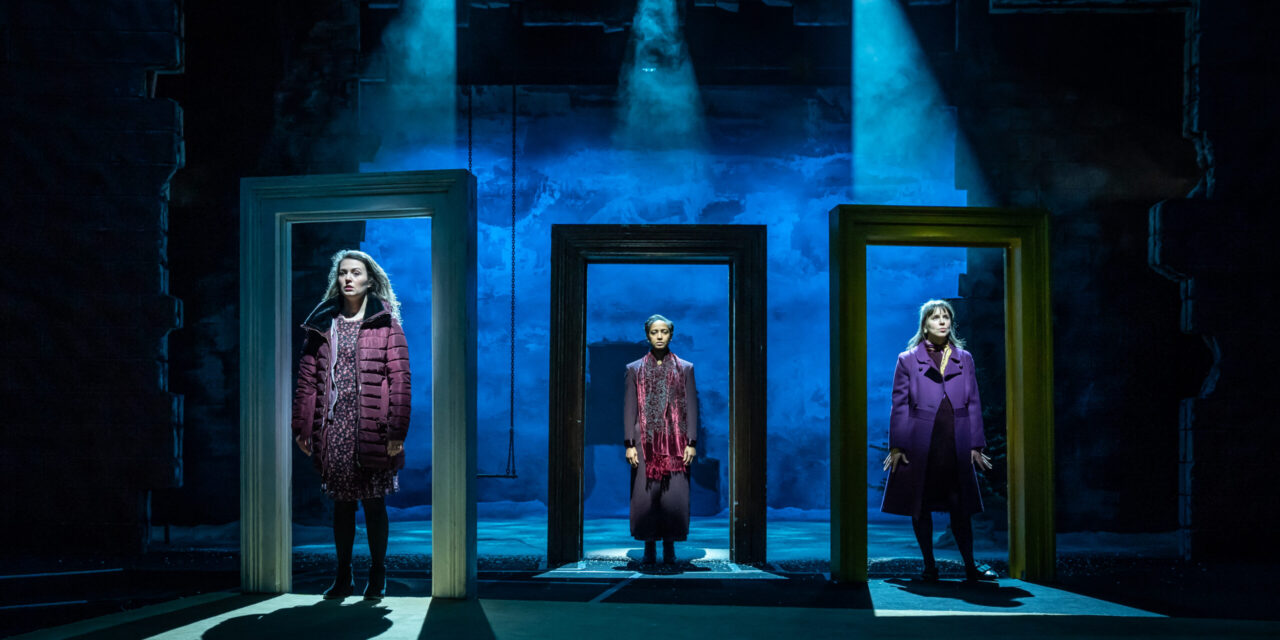A woman walks into her home. Then does another. And another.
Stef Smith’s Nora: A Doll’s House is not merely an adaptation of Ibsen’s 1879 play. It is three adaptations superimposed on one another, each in direct conversation with the other two. There are, after all, three Noras in Smith’s version, each positioned at a different point in time—1918, 1968, and 2018—but fully embedded in others, too. In her re-write, Smith transforms the play’s central character into a choral multitude that spans and fuses discrete generations. The premise recalls the doctrine of the Trinity: in ways that seem to defy comprehension and consistency, the three women are at once unified and separate.
Elizabeth Freestone’s poised production at the Young Vic treats this triadic conceit with fluid ease. Three doorframes stand erect in the middle of Tom Piper’s abstracted set. Behind them is a demolished brick wall; in the front, a few scattered chairs. It’s a domestic battlefield from which no one emerges unscathed. Entrances and exits are of no concern to the three women, however. Anna Russell-Martin, Natalie Klamar, and Amaka Okafor—all brilliant—remain on stage throughout the play, exchanging the roles of Nora and her friend Christine, and occasionally becoming silent bystanders. Russell-Martin is the contemporary heroine, her speech throbbing with swear words and familiar rhythms of exasperation. Klamar plays the 1968 Nora, a sympathetic mixture of bashfulness and anxiety. And Okafor delivers the 1918 version with fitting, freighted composure.
Against them stands a single actor as Nora’s husband Thomas. Luke Norris gives a dashingly inclusive performance that manages to fit into all three periods without much modulation. Mark Arends (as blackmailer Nathan) and Zephryn Taitte (as pharmacist Daniel) navigate the play’s hall of mirrors with similar confidence, helping blur the boundaries between its different temporalities—which are already thin and translucent.
Smith has chosen three moments in history that are charged with particular significance for women’s lives. Concluding the First World War, 1918 marks the year of suffrage. 1968 is when the Abortion Act was passed in the UK, and when the pill came into common usage. And, of course, 2018 saw the pinnacle of the #MeToo movement. Some of these socio-political details creep into the dialogue, enriching the contexts in which Nora’s gradual awakening into her mental and financial captivity occurs. Smith expands and rethinks Ibsen’s work also by giving narrative voice to her three Noras. The play boasts a number of fine moments when the women describe themselves—and each other—in the third person, as though they were speaking from a distant position of maturity.
There are other additions to the source text, some of which—like the 1968 Nora’s burgeoning affair with Christine—remain half-baked. But for the most part, Smith’s adaptation is admirable for its daring invention. While Nora’s multiplied selves do not end up multiplying the play’s expected impact, their consistent triangulation of Nora’s story makes for a strangely refreshing experience. Their haunting references to the river outside of their home—whose cold waters loom large as a potential source of relief—tap into the darker energies of Ibsen’s play, as do their small acts of self-harm.
At the end, when the three women walk out of their homes, no door gets slammed. Instead, Smith draws a separate path for each of her Noras, focusing our attention on the question of their aftermaths. We are asked to pry beneath the surface of what we accept to be a radical act—and to reconsider what will change and what will persist, both in their lives and beyond them. What if, asks this lyrical remix of A Doll’s House, not every escape is a liberation? What if truth, happiness, and love are not enough to shatter the doll-wife to smithereens? What if?
This post was written by the author in their personal capacity.The opinions expressed in this article are the author’s own and do not reflect the view of The Theatre Times, their staff or collaborators.
This post was written by Mert Dilek.
The views expressed here belong to the author and do not necessarily reflect our views and opinions.


















